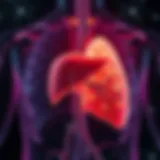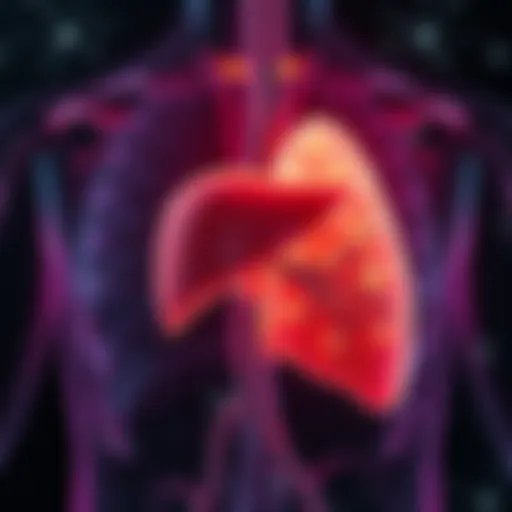Understanding Neurofibromatosis: The Quest for a Cure


Intro
Neurofibromatosis is a genetic disorder that presents unique challenges for affected individuals and the medical community. Characterized by tumor growth along nerves, it manifests in different forms, primarily neurofibromatosis type 1, type 2, and schwannomatosis. This genetic condition raises questions about its implications for health, treatment, and the elusive quest for a cure. The need for comprehensive understanding is critical, considering its significant impact on the quality of life for those diagnosed.
As research continues, advancements in genetic science shed light on potential treatment options. This article will explore the intricacies of neurofibromatosis, examine current therapeutic strategies, and discuss the ongoing research landscape aimed at finding a definitive cure.
Prologue to Neurofibromatosis
Neurofibromatosis is a genetic disorder that impacts not only individuals but also families and communities. Understanding it is critical for those affected and for healthcare professionals. This condition leads to the formation of tumors on nerves, which can affect various body systems. The importance of exploring neurofibromatosis in this article lies in its complexity and the ongoing quest for effective treatments and potential cures.
Grasping the types, genetic aspects, and treatment problems helps inform better clinical practices and patient experiences. The article will look at various facets of neurofibromatosis, such as its types, symptoms, and current management strategies. By engaging with these details, readers will gain insights that are necessary for both education and advocacy.
Definition and Overview
Neurofibromatosis refers to a group of hereditary conditions characterized mainly by the growth of tumors in the nervous system. These tumors can appear on or under the skin, and on peripheral nerves, and they can disrupt normal function. The condition varies widely in severity and symptoms, making individualized assessment essential.
Awareness of neurofibromatosis is critical, not only for those diagnosed but also for their families. Understanding its nature lays the foundation for better management and potential treatment options.
Types of Neurofibromatosis
There are several types of neurofibromatosis, each with distinct features and implications:
Neurofibromatosis Type One
Neurofibromatosis Type One (NF1) is one of the most common forms of the disorder. Its key characteristic is the presence of multiple neurofibromas, which are benign tumors on nerves. NF1 can also cause skin changes, bone deformities, and learning disabilities.
This type is often a focus of research because of its prevalence. Understanding NF1’s features aids in developing special management plans for patients. The unique aspect of NF1 is its variable expressivity, meaning symptoms can vary significantly from person to person. This can complicate diagnosis and management.
Neurofibromatosis Type Two
Neurofibromatosis Type Two (NF2) is defined by the growth of bilateral vestibular schwannomas, tumors that affect the auditory nerve. Patients often experience hearing loss, tinnitus, and balance issues as primary symptoms.
NF2 requires different management strategies compared to NF1 due to its distinct tumor type and locations. Highlighting NF2 is essential in this discussion as it represents a paradigm shift in understanding the neurological impact of neurofibromatosis.
Schwannomatosis
Schwannomatosis is another, less common type characterized by the presence of Schwannomas, benign tumors that arise from Schwann cells. The primary concern for patients includes chronic pain which can significantly impact quality of life.
Discussing Schwannomatosis is important because it shows the broad spectrum of neurofibromatosis-related disorders. The unique feature of Schwannomatosis is that it frequently presents with pain rather than other neurological symptoms, making it a unique challenge in management.
Each form of neurofibromatosis presents different challenges and increases the importance of understanding individualized patient care.
Genetic Basis of Neurofibromatosis
Understanding the genetic foundation of neurofibromatosis is crucial for grasping its complexities and potential interventions. Genetic factors play a significant role in how the condition manifests in individuals. This understanding aids in developing targeted treatment options and provides insight into individual patient prognoses.
Inheritance Patterns
Neurofibromatosis has different inheritance patterns based on its type. Neurofibromatosis Type One (NF1) follows an autosomal dominant inheritance pattern. This means that only one copy of the mutated gene can cause the disorder. If a parent has NF1, there is a 50% chance of passing the condition to each child.
In contrast, Neurofibromatosis Type Two (NF2) also exhibits an autosomal dominant pattern but involves a different gene than NF1. Additionally, Schwannomatosis is usually inherited in a similar way, although not all cases are hereditary, and some appear sporadic.
Recognizing these patterns allows healthcare providers to offer genetic counseling. This is essential for families impacted by the disorder. They can better understand their risks and make informed decisions concerning family planning.
Mutation Mechanisms
The specific gene mutations responsible for neurofibromatosis provide insight into its pathophysiology. For NF1, mutations occur in the NF1 gene, which is responsible for producing neurofibromin. Neurofibromin acts as a tumor suppressor, and its absence leads to uncontrolled cell growth, contributing to tumor formation.
For NF2, the primary gene implicated is the NF2 gene, which codes for merlin, another crucial tumor suppressor. Mutations in this gene cause various nerve tumors, including vestibular schwannomas. In Schwannomatosis, mutations in different genes, such as SMARCB1 and LZTR1, are associated, revealing a broader scope of genetic mechanisms at work.
The characterization of these mutations assists in understanding individual cases of neurofibromatosis. Moreover, it offers potential avenues for targeted therapies. Research into these mechanisms is critical for advancing treatment strategies. Understanding how these mutations lead to disease informs the development of clinical trials focused on gene therapy and targeted drug interventions.
"Genetic understanding is fundamental in potentially uncovering therapeutic targets that can modify the course of neurofibromatosis."
In summary, examining the genetic basis of neurofibromatosis is paramount. By knowing inheritance patterns and mutation mechanisms, we take significant strides towards a future where better management and possibly even a cure for neurofibromatosis may become a reality.
For more detailed information on neurofibromatosis and genetics, consider visiting Wikipedia and Britannica.
Symptoms and Complications
The topic of symptoms and complications associated with neurofibromatosis is crucial for understanding the full impact of this genetic disorder. Neurofibromatosis affects individuals uniquely, leading to a diverse array of symptoms. For patients and healthcare providers alike, recognizing these manifestations is essential for timely diagnosis and appropriate management. Symptoms can often guide treatment strategies, while complications might dictate a more aggressive approach.
Physical Manifestations
Physical signs of neurofibromatosis frequently present first during childhood or adolescence. Common manifestations include:


- Neurofibromas: These benign tumors typically arise along nerves. They can be soft to the touch and may vary in size. Some individuals can have numerous tumors, complicating physical wellbeing.
- Café-au-lait spots: These skin pigmentation marks are often present from birth. More than six spots on the body can indicate a higher likelihood of neurofibromatosis. The size and number of these spots are critical in diagnostics.
- Lisch nodules: These are harmless growths in the iris of the eye. While they do not affect vision, their presence can be a diagnostic indicator of neurofibromatosis type one.
- Skeletal abnormalities: Some patients may also experience significant skeletal issues like scoliosis or short stature, which can impact their quality of life.
Understanding these physical signs not only assists in recognizing the disorder but also shapes patient management.
The complexity lies in the variability of these manifestations. Not all individuals will present the same symptoms, making individualized assessments imperative.
Neurological Implications
Neurofibromatosis poses substantial neurological implications that require attention and understanding.
- Cognitive challenges: Some individuals may experience learning disabilities or attention issues. These cognitive aspects can heavily impact daily life, necessitating tailored educational strategies.
- Seizure disorders: In certain cases, individuals with neurofibromatosis might develop seizures due to the growth of tumors in the brain, pushing for careful monitoring and management.
- Malignant transformation: Although rare, some neurofibromas can transform into malignant peripheral nerve sheath tumors (MPNST). Early detection is crucial, as it significantly affects treatment outcomes.
Patients and families should be aware of these neurological factors as they work with their healthcare providers to tailor a management approach. Being informed can help better prepare them for potential complications, ensuring an enhanced focus on overall well-being.
The diversity of symptoms and the potential for complications underscore the need for ongoing research and comprehensive clinical care. Identifying and addressing these issues are essential for improving the lives of those impacted by neurofibromatosis.
Diagnosis of Neurofibromatosis
Diagnosing neurofibromatosis is crucial in managing the condition effectively. Early detection allows for prompt monitoring of symptoms and intervention strategies that can mitigate complications. Accurate diagnosis is often a multi-faceted process that involves patient history, clinical evaluation, and advanced imaging techniques. Each of these elements plays a vital role in understanding the disease's extent and formulating an appropriate treatment plan.
Clinical Evaluation
A thorough clinical evaluation is the first step in diagnosing neurofibromatosis. This generally involves a detailed assessment of the patient’s medical history and a physical examination. Clinicians look for specific signs such as café-au-lait spots, neurofibromas, and Lisch nodules.
Furthermore, family history can provide insights, especially since neurofibromatosis is often inherited. The physical exam may reveal skin changes, lumps, and neurological symptoms. In light of these observations, genetic tests may be recommended to confirm a diagnosis or understand the type of neurofibromatosis present.
Imaging Techniques
Imaging techniques are essential adjuncts to clinical evaluation in the diagnosis of neurofibromatosis. They provide clear images of internal structures that helps assess tumors or fibromas that may not be apparent during physical examinations. There are two primary imaging modalities used:
Magnetic Resonance Imaging
Magnetic Resonance Imaging (MRI) is a preferred method for its ability to capture detailed images of soft tissues. One key characteristic of MRI is its non-invasive nature, meaning it poses minimal risk to the patient. MRI is particularly beneficial for evaluating the central nervous system and surrounding areas, which is critical for assessing tumor location and size.
Moreover, it can detect subtle changes that may indicate complications from neurofibromatosis. However, it does have some limitations, including longer wait times and the need for patients to remain still during scanning, which can be uncomfortable.
Computed Tomography
Computed Tomography (CT) scans are another valuable tool in diagnosing neurofibromatosis. This imaging technology provides quick and clear images of cross-sections of the body. The key characteristic of CT scans is their speed; they often offer faster results compared to MRI.
CT is especially useful in emergency situations or when a rapid assessment is needed. However, CT scans involve exposure to ionizing radiation, which poses a risk, especially for young patients or those requiring multiple evaluations over time. This risk must be balanced with the need for accurate and timely information regarding tumor presence and size.
Diagnostic tests like MRI and CT scans are indispensable in understanding the complexities of neurofibromatosis.
Overall, both imaging modalities play complementary roles in the diagnostic pathway. By combining the results of clinical evaluations with advanced imaging, healthcare providers can better understand the condition, anticipate complications, and create a strategic management plan.
Current Treatment Approaches
The treatment of neurofibromatosis is intricate and often multifaceted. It aims to provide relief from symptoms, manage complications, and improve the quality of life for patients. Understanding current treatment approaches is crucial as it sheds light on available options and adapts to the dynamic nature of this condition. Treatments are categorized mainly into surgical interventions and pharmacologic management, each with unique benefits and considerations.
Surgical Interventions
Surgical interventions often become necessary for patients who develop large or symptomatic tumors associated with neurofibromatosis. Surgeries are typically performed to remove tumors, alleviate pressure on nearby nerves, or address cosmetic concerns. Patients with Neurofibromatosis Type One may benefit from surgery to remove neurofibromas, which are usually benign tumors. Consideration for surgery depends on tumor size, location, and the presence of any neurological symptoms.
It is important to note that while surgery can provide immediate relief, it does not eradicate the underlying genetic condition. Tumors may recur after removal, necessitating ongoing monitoring and possible additional interventions. Each patient's situation is unique, requiring a personalized approach to surgical treatment. Collaboration among a multidisciplinary team, including neurologists and oncologists, is essential for optimal outcomes.
Pharmacologic Management
Pharmacologic management plays a significant role in treating symptoms and complications of neurofibromatosis. Currently, there is no universally accepted medication to treat the disorder entirely. However, various drugs can help manage specific symptoms, such as pain or anxiety, associated with the condition. Non-steroidal anti-inflammatory drugs (NSAIDs) are commonly used for pain relief, particularly for patients experiencing discomfort from tumors. Additionally, medications targeting neuropathic pain may also offer relief for some individuals.
Researchers are exploring more targeted therapies and their effects on the neurofibromatosis population. Recent clinical trials are examining drugs such as selumetinib, a MEK inhibitor that shows promise in reducing the size of neurofibromas. This pharmacologic approach is significant as it targets the biological pathways specific to the growth of tumors, representing a shift towards personalized medicine in treating neurofibromatosis.
"Understanding and improving treatment options for neurofibromatosis is essential not only for managing symptoms but also for enhancing the overall quality of life for those affected by this condition."
In summary, current treatment approaches for neurofibromatosis focus on symptom management through both surgical and pharmacologic means. Each method offers distinct benefits, and ongoing research continues to expand the horizon of available treatments for patients.
Challenges in Treatment
The complexities surrounding neurofibromatosis presents significant barriers to effective treatment. Understanding these challenges is crucial for healthcare providers, researchers, and patients alike. When devising treatment strategies, it is essential to acknowledge the unique characteristics of neurofibromatosis and how they complicate patient care.
Variability in Symptoms
One of the primary challenges in treating neurofibromatosis is the wide variability in symptoms among patients. Each individual may experience a different combination of manifestations, ranging from mild skin lesions to severe neurological complications.
- Diverse Clinical Presentation: The variation in symptoms can lead to delays in diagnosis. For instance, neurofibromatosis type 1 may present with cafe-au-lait spots or neurofibromas, while type 2 is often characterized by bilateral vestibular schwannomas. Such differences necessitate tailored treatment protocols.
- Symptom Progression: Symptoms may also evolve over time. Some patients may find their condition worsens during adolescence or adulthood. This unpredictability complicates the management efforts by healthcare professionals. Regular monitoring is often needed, requiring more resources and time.


"The manifestation of neurofibromatosis is unique to each patient, often leading to misdiagnosis and suboptimal treatments."
Limited Therapeutic Options
Despite advancements in medicine, therapeutic options for treating neurofibromatosis remain limited. Current treatment strategies mainly focus on managing symptoms rather than addressing the underlying genetic causes.
- Surgical Interventions: While surgical removal of tumors can provide relief, it does not eradicate the genetic predisposition to develop new tumors. This approach may provide temporary relief but does not equate to a true cure.
- Pharmacological Management: Medications may help manage symptoms or slow tumor growth, but options are constrained. Drugs like selumetinib show promise in clinical studies, yet they are not universally effective.
- Lack of Targeted Therapies: There remains a critical lack of specifically targeted therapies for neurofibromatosis. Research is ongoing, but the journey from laboratory findings to clinical application can be lengthy.
Research Directions
Research directions in neurofibromatosis are pivotal for advancing our understanding of this complex genetic disorder. In the quest for effective treatments and potentially a cure, exploring innovative research avenues can uncover new therapeutic targets and improve patient outcomes. Significant focus is currently being placed on gene therapy approaches and targeted drug therapies, which promise to tailor treatments to the specific genetic anomalies that characterize the different types of neurofibromatosis.
The exploration of these directions is multi-faceted. It integrates genetic research, clinical trials, and patient-centered studies. Researchers aim not only to understand the pathophysiology of neurofibromatosis but also to translate these findings into therapeutic strategies that can substantially enhance the quality of life for those affected. The continuous evolution of technology, especially in genomics, plays a crucial role in this endeavor. This is essential for developing and refining treatment methods that are both effective and safe, addressing the unique challenges posed by neurofibromatosis.
Gene Therapy Approaches
Gene therapy represents a promising frontier in the treatment of neurofibromatosis. The essence of this approach lies in correcting or replacing defective genes responsible for the disorder. By delivering therapeutic genes into the affected tissues, the aim is to halt or reverse the growth of tumorigenic cells.
Recent advancements in vector technology, such as using adenoviral vectors or lentiviral vectors, enhance the delivery efficiency of therapeutic genes. Furthermore, CRISPR-Cas9 technology has emerged as a tool that may allow for precise gene editing, offering the potential to directly rectify genetic mutations. The potential benefits of gene therapy include:
- Targeted Treatment: Focused attack on the genetic root causes.
- Customization: Treatments can be tailored to the molecular characteristics of an individual's tumors.
- Long-term Effects: Potential for lasting structural and functional improvements in affected tissues.
However, there are hurdles. Safety concerns regarding off-target effects and the immune response to viral vectors need thorough investigation. Ethical considerations regarding genetic modifications also present challenges that must be addressed as research progresses.
Targeted Drug Therapies
Targeted drug therapies focus on specific molecular targets that play a fundamental role in the growth and development of neurofibromatosis tumors. Unlike traditional chemotherapy, which affects all rapidly dividing cells, these therapies aim to interfere with particular molecules involved in tumor proliferation and survival. For instance, drugs that inhibit the MEK pathway, like trametinib, have shown promise in clinical studies for neurofibromatosis type 1
The advantages of targeted drug therapies include:
- Increased Efficacy: More effective in shrinking tumors due to specificity.
- Reduced Side Effects: Less impact on normal tissues decreasing adverse reactions.
- Combination Strategies: Potential to combine with other therapies for enhanced results.
Potential for a Cure
Exploring the potential for a cure in neurofibromatosis is vital for those affected by this genetic condition. This area encapsulates not only scientific advancements but also the hope and future of treatments that could significantly alter the landscape of care for individuals with neurofibromatosis. Understanding the mechanisms that drive the disease and the direction of ongoing research allows for greater anticipation of breakthroughs that might lead to effective remedies. Given the variability of symptoms, targeted and individualized therapies become essential aspects of the conversation surrounding potential cures.
Theoretical Frameworks
In the search for a cure for neurofibromatosis, various theoretical frameworks guide researchers. These frameworks often center around genetic manipulation and innovative treatment modalities. Gene therapy, for instance, seeks to correct or replace defective genes responsible for disease expression. This method is particularly promising given the genetic underpinnings of neurofibromatosis, where mutations in specific genes, such as the NF1 and NF2 genes, are known to play crucial roles. By developing strategies to deliver corrective genes, researchers hope to influence tumor growth dynamics and promote normal nerve function.
Targeted drug therapies also represent a significant aspect of the theoretical framework. These treatments focus on specific pathways involved in tumor growth and maintenance, such as the MEK/ERK signaling pathway in neurofibromatosis type 1. By leveraging small molecule inhibitors, researchers have the opportunity to reduce tumor burden and improve quality of life for patients. Theoretical models simulate treatment outcomes and provide insight into the most promising directions for clinical trials, fostering a systematic approach to research.
Success Stories and Case Studies
Despite the challenges, there are notable success stories and case studies that underscore the potential for curative treatments in neurofibromatosis. For example, some clinical trials have shown significant regression in plexiform neurofibromas with the use of targeted therapies like Selumetinib. This drug, designed to inhibit the MEK protein, has demonstrated the ability to shrink tumors in multiple cases, leading to improved functional outcomes for patients.
Additionally, anecdotal evidence from patients undergoing experimental therapies highlights the transformative potential of research efforts. Patients who have participated in investigative trials often report not just physical improvements, but also enhanced psychological well-being, as the reduction in tumor size and symptoms alleviates the academic and social challenges of living with neurofibromatosis.
"The advancements in treatment options offer a glimpse of hope where previously there was none; we must continue to push for research and funding to turn these possibilities into realities."
The trajectory of research in neurofibromatosis indicates a promising horizon where cures may eventually become a reality. By focusing on the underlying genetics and implementing innovative therapeutic frameworks, the potential for effective interventions remains within reach.
Ethical Considerations in Treatment Research
When addressing neurofibromatosis, ethical considerations in treatment research emerge as a focal point. It is imperative to navigate this terrain with sensitivity and care. The complexities of human subject research necessitate robust ethical frameworks to protect participants while advancing knowledge.
Informed consent is a critical element of ethical research. Participants must fully understand their rights and the potential risks and benefits involved in clinical trials. This means researchers have to provide clear, comprehensive information. Patients should feel confident they are making educated choices about participation. Transparency fosters trust, which is vital for recruiting volunteers for studies focused on producing effective treatments for neurofibromatosis.
Access to experimental treatments also raises ethical questions. Patients with neurofibromatosis often face limited options. The quest for a cure can tempt researchers to prioritize speed over thorough investigations. However, ensuring equitable access to these treatments is necessary. All patients, regardless of their background, should have opportunities to participate in trials. This inclusivity enriches research outcomes and helps ensure that findings are applicable to diverse populations.
As researchers and clinicians continue to explore the potential for cures, ethical considerations will remain a central component.
"Ethics is not a technical issue. It belongs to everyone, and everyone must accept the implication of decisions made in research."
In summary, ethical considerations in treatment research are not mere formalities. Instead, they are foundational to the integrity of research initiatives aimed at neurofibromatosis. They shape how patients interact with research, influence participation, and ultimately affect the quest for viable treatments.
Patient Advocacy and Support
Patient advocacy and support play a crucial role in the journey of individuals affected by neurofibromatosis. As a genetic condition with complex symptoms and varied treatment paths, advocacy provides a voice for patients. It fosters a sense of community and connection among patients, families, and healthcare providers. This network is essential not only for emotional support but also for navigating the medical system.
Advocacy raises awareness about neurofibromatosis, highlighting its impact on daily life. Often, individuals face challenges in understanding their condition, including uncertainties about prognosis and treatment options. Support groups serve as platforms for sharing experiences and strategies. Through these interactions, patients can gain insights that may not be readily available in clinical settings.
Benefits of Patient Advocacy:
- Empowerment: Patients learn to advocate for their own needs within the healthcare system.
- Information Sharing: Access to up-to-date research and treatment options through community resources.
- Emotional Resilience: Building relationships with others facing similar challenges fosters emotional support.


Effective patient advocacy not only enhances individual care but also influences public policy and research priorities, potentially leading to advancements in treatment.
The importance of advocacy extends beyond emotional needs; it often drives clinical research. Patient perspectives can inform researchers about real-world implications of neurofibromatosis, leading to better-targeted therapies.
Role of Support Groups
Support groups offer a structured way for individuals dealing with neurofibromatosis to connect. These groups create a safe environment for sharing feelings, frustrations, and triumphs. Members often exchange practical advice about coping with symptoms or accessing healthcare resources. Facilitated discussions can help reduce feelings of isolation, a common experience among those with chronic health conditions.
The groups vary widely. Some focus on specific types of neurofibromatosis, while others may encompass a broader spectrum of related conditions. Regular meetings, either in person or online, allow continuous engagement.
In addition, some support groups work closely with healthcare professionals, creating bridges between medical guidance and patient experiences. This collaboration can lead to improved care and new support mechanisms tailored to patient needs.
Importance of Awareness Campaigns
Awareness campaigns are vital in promoting understanding of neurofibromatosis among the general public and healthcare providers. These initiatives strive to provide accurate information, dispelling myths and educating about the condition’s hereditary nature. Greater awareness can lead to earlier diagnoses, improved treatment outcomes, and a more compassionate community response.
Effective campaigns utilize various platforms, including social media, community events, and educational outreach in schools and healthcare facilities. They aim to engage audiences in meaningful conversations about neurofibromatosis.
Key components of successful awareness campaigns include:
- Educational Materials: Providing brochures, videos, and online resources showcases symptoms and treatment options.
- Public Events: Organizing walks or informational days to draw community involvement and raise funds for research.
- Collaborational Efforts: Partnering with healthcare institutions and universities can amplify the reach and credibility of the campaign.
By increasing visibility, these campaigns empower patients and families to share their stories and advocate for their needs. Ultimately, awareness can fuel progress in research funding, fostering a future with more robust solutions for neurofibromatosis.
Future Perspectives
The study of neurofibromatosis encompasses challenges and breakthroughs that shape the journey toward a potential cure. Embracing the future of treatment requires understanding integrative approaches and technological innovations. These perspectives not only hold key promises for individuals affected by the condition but also redefine the very essence of medical research.
Integrative approaches combine various methodologies to enhance treatment effectiveness. This could involve leveraging traditional methods with modern therapies, creating a more holistic care model that addresses both physical and psychological aspects of the disorder. Additionally, incorporating patient feedback into treatment plans fosters a more personalized health journey, addressing individual needs rather than relying solely on one-size-fits-all solutions.
Technological innovations play a crucial role in the quest for a cure. Since neurofibromatosis involves complex genetic factors, advancements in gene editing technologies, such as CRISPR, have captured researchers' attention. These tools enable precise alterations at the genetic level, providing opportunities for groundbreaking therapies that may significantly mitigate or even correct the genetic anomalies associated with neurofibromatosis.
"Exploring new frontiers in treatment can uplift current paradigms and inspire hope in the quest for a cure."
By examining future perspectives in this area, stakeholders can align their efforts with emerging science, ensuring that research addresses the real needs of patients. As knowledge evolves, the integration of diverse insights and innovations will likely bring us closer to novel therapies. The emphasis on collaboration within the medical, academic, and patient communities is essential. Together, shared resources and knowledge can lead to discoveries that elude isolated efforts.
Integrative Approaches in Treatment
Integrative approaches in treatment advocate for a more comprehensive understanding of neurofibromatosis. This can include combining surgical interventions with pharmacologic management, thus creating a balanced treatment plan that encompasses various healing modalities. By tailoring therapies to specific patient needs, practitioners can better address the multifaceted nature of this condition.
In addition to medical treatments, patient support and education must be part of these approaches. Educating families and individuals about managing symptoms and coping mechanisms contributes significantly to overall patient well-being. Furthermore, knowledge-sharing programs help foster a sense of community, enabling patients to share experiences and resources, thus enriching their treatment journeys.
Technological Innovations
The landscape of neurofibromatosis treatment is poised for transformation through technological innovations. Tools like advanced imaging techniques are crucial in understanding the progression of tumors associated with the condition. Moreover, these technologies contribute to surgical precision, offering better outcomes.
Genomic advancements are equally significant. Technologies that facilitate rapid genetic sequencing provide insights into the genetic underpinnings of neurofibromatosis. This ability to decode genetic information facilitates targeted treatment options and better predictions of disease trajectory. Overall, the intersection of technology and medical research fosters an environment ripe for innovative therapies that might alleviate the burdens of neurofibromatosis.
Finale
The conclusion serves as a vital component of this article, wrapping up the intricate details surrounding neurofibromatosis while emphasizing its complexities. This section highlights the significance of understanding the implications that arise from both the study of neurofibromatosis and the ongoing research into finding a cure.
In summary, the synthesis of findings discussed throughout sheds light on the various aspects of neurofibromatosis. It underscores the need for thorough comprehension of the genetic and clinical challenges that patients endure. Additionally, drawing attention to the progress in treatment options and the hopeful advancements in research gives a balanced perspective on the current state of affairs.
By emphasizing the interplay between scientific discovery and patient experience, this conclusion serves several purposes:
- Comprehensive Summary: It succinctly recaps key insights, ensuring that readers leave with a clear understanding of the main themes.
- Reinforcement of Importance: It stresses the need for continued research and advocacy for affected individuals, urging a concerted effort from the medical community and society as a whole.
- Guidance for Future Research: It posits questions and considerations that researchers might address moving forward, paving the way for further exploration in neurofibromatosis.
Thus, the conclusion not only encapsulates the essential points discussed but also depicts a roadmap for future inquiries and engages the reader to consider the broader impacts of neurofibromatosis on affected individuals and their families.
Summary of Findings
Throughout the article, several critical findings about neurofibromatosis have emerged. The most pertinent include:
- Genetic Underpinnings: Neurofibromatosis is rooted in genetic mutations that lead to multiple tumor formations. Understanding these mutations is crucial for reliable diagnosis and treatment options.
- Types and Symptoms: Recognizing the distinctions between Neurofibromatosis Type One, Neurofibromatosis Type Two, and Schwannomatosis reflects not only on the symptoms but also on the varying treatments available.
- Treatment Landscape: Current surgical and pharmacologic interventions hold promise yet come with limitations, as each patient's experience with symptoms can greatly differ.
These findings collectively emphasize the multifaceted nature of neurofibromatosis. They call for a more personalized approach in treatment to enhance the quality of life for those affected.
Implications for Patients and Researchers
The implications of the findings extend far beyond academic understanding—they resonate deeply within the lives of patients and the goals of researchers.
For patients, the information highlights the importance of:
- Hope for Therapeutic Approaches: Understanding potential breakthroughs in gene therapy and targeted drug therapies may inspire optimism in patients seeking effective treatments.
- Engagement in Advocacy: Participation in support groups and awareness campaigns can significantly impact the recognition and resources allocated to neurofibromatosis research.
For researchers, these insights indicate:
- Focus on Interdisiciplinary Collaboration: The need for cooperation between geneticists, neurologists, and oncologists is vital to develop comprehensive treatment strategies.
- Prioritizing Patient-Centric Research: Studies should aim to address varied phenotypes of neurofibromatosis to ensure that treatments are effective across diverse patient experiences.
Ultimately, a mutual understanding between patients and researchers can foster an environment where advancements are made collaboratively. This could pave the way for a future where the implications of neurofibromatosis on daily life are mitigated by effective treatments and a deeper understanding of the condition's nuances.



